从语用学角度分析广告语
- 格式:doc
- 大小:86.76 KB
- 文档页数:12
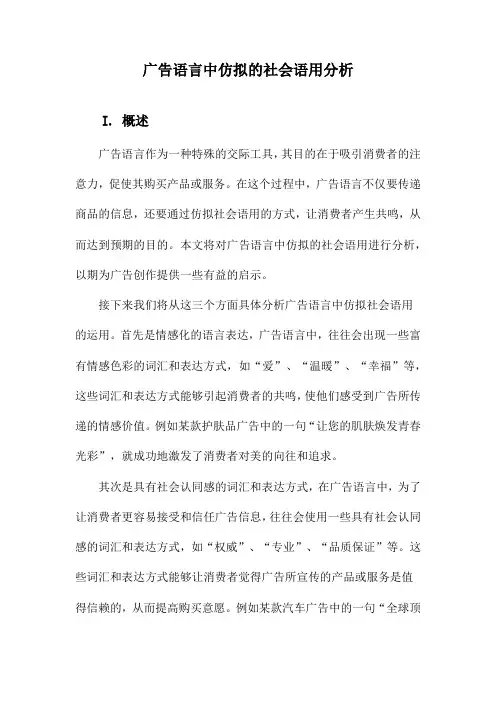
广告语言中仿拟的社会语用分析I. 概述广告语言作为一种特殊的交际工具,其目的在于吸引消费者的注意力,促使其购买产品或服务。
在这个过程中,广告语言不仅要传递商品的信息,还要通过仿拟社会语用的方式,让消费者产生共鸣,从而达到预期的目的。
本文将对广告语言中仿拟的社会语用进行分析,以期为广告创作提供一些有益的启示。
接下来我们将从这三个方面具体分析广告语言中仿拟社会语用的运用。
首先是情感化的语言表达,广告语言中,往往会出现一些富有情感色彩的词汇和表达方式,如“爱”、“温暖”、“幸福”等,这些词汇和表达方式能够引起消费者的共鸣,使他们感受到广告所传递的情感价值。
例如某款护肤品广告中的一句“让您的肌肤焕发青春光彩”,就成功地激发了消费者对美的向往和追求。
其次是具有社会认同感的词汇和表达方式,在广告语言中,为了让消费者更容易接受和信任广告信息,往往会使用一些具有社会认同感的词汇和表达方式,如“权威”、“专业”、“品质保证”等。
这些词汇和表达方式能够让消费者觉得广告所宣传的产品或服务是值得信赖的,从而提高购买意愿。
例如某款汽车广告中的一句“全球顶级发动机技术”,就让消费者对该汽车的技术水平产生了信心。
最后是模拟现实生活中的场景和对话,为了使广告更加贴近消费者的生活实际,广告语言中常常会模拟现实生活中的场景和对话,让消费者在观看广告的过程中产生代入感。
这种仿拟社会语用的运用方式,既能让消费者更容易理解广告信息,也能增加广告的趣味性和吸引力。
例如某款饮料广告中的一组场景描绘了一个家庭聚会时,大家围坐在一起畅饮的情景,这让消费者感受到了这款饮料带来的欢乐氛围。
广告语言中仿拟社会语用的运用是一种有效的沟通策略,它能够让广告更加生动、有趣、具有说服力。
然而过度的仿拟社会语用可能会让广告显得不真实、做作,甚至引起消费者的反感。
因此在广告创作过程中,广告人需要在情感化、社会认同感和现实生活的模拟等方面找到一个适度的平衡点,以实现最佳的传播效果。
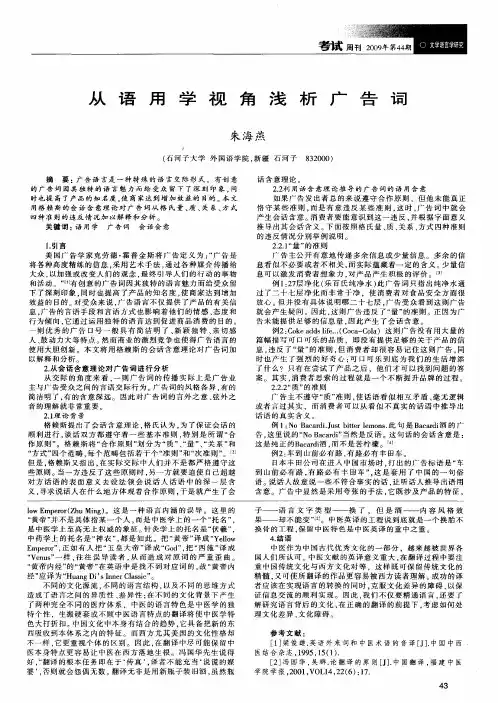

言语行为理论视角下的食品广告用语研究作者:王天钰来源:《青年时代》2019年第25期摘要:广告作为一种特殊文本,其主要目的是吸引消费者的注意力,从而说服消费者购买产品。
广告种类众多,其中,食品广告语以其独有的特点频繁出现。
广告的独特魅力也引起了学者的广泛关注。
近年来,研究者从社会学,翻译学等角度对广告语进行了研究。
然而,在已有研究中,从语用学角度对其分析得并不多。
因此,本文以奥斯汀和塞尔的言语行为理论为基础,通过收集一些常见的英语食品广告语,探求言语行为理论影响下英语食品广告语的表现形式及应用。
关键词:言语行为;间接言语行为理论;广告语言一、引言广告作为一种营销手段,是连接生产商和消费者之间的桥梁,新颖奇特的广告总是能给人留下深刻的印象。
众所周知,食物对于生命有着重要的意义。
随着时代的进步,食物的功能并不仅仅局限于满足生理需求,更是人们取得精神愉悦的一种媒介。
为了吸引更多的人购买产品,全球各地的食品生产者们设计出了精彩的广告语,成功地吸引了大批的消费者。
本文将从语用学的视角,结合言语行为理论,对一些英语食品广告进行分析。
本文主要解决两个问题:第一,言语行为理论在广告中如何被应用;第二,言语行为理论对广告语言有什么影响。
为了解决这两个问题,本研究采用了定性分析的方法。
作者将通过网上搜索,阅读各种报纸、杂志等,搜集大量含有言语行为理论的英语广告,并选取一些经典的食品广告语进行研究。
本文将从言内行为、言外行为、言后行为和间接言语行为4个方面进行分析,选取不同的广告作为语料,并进一步分析所选语料中使用言语行为理论产生的语用效果,在此基础上发现食品广告语所运用的语用规律,对指导其他类型广告语创作也有着重要的意义。
二、文献综述(一)广告语理论1.广告的定义“广告”一词来源于拉丁语“adverture”,意为“注意”或“引导”。
商业企业利用这一媒介,以促进商品推销为目的,将自己经营的商品向顾客进行说明介绍,从而发挥其宣传、推广新产品的作用,满足消费者不同的爱好与需求。
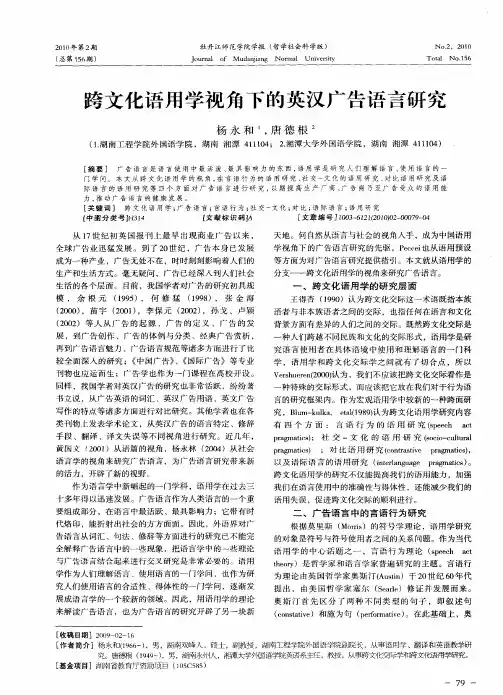
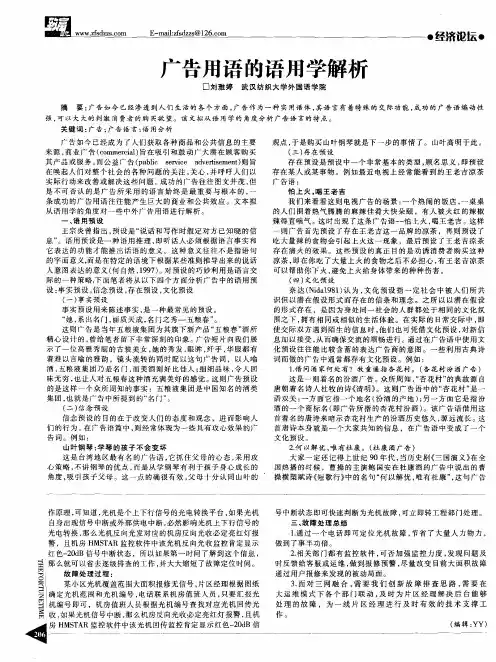

语用预设在广告用语中的运用摘要广告语言的研究一直以来都备受各个领域学者们的青睐,而语言学的发展使得广告语言的研究逐渐趋向于语言和语境的关系研究。
语用预设相对于话语理解而言具备合适性和共知性,而其本身则具有单向性、主观性和隐蔽性。
广告是一种极具策略性的交际行为,广告用语正是巧妙地运用了语用预设这三个特性衍生出交际所需的策略性。
因此,从语用预设的视角研究广告语言是十分有意义的。
关键词:广告用语语用预设特征策略中图分类号:h15 文献标识码:a在各种商品充斥着市场的大环境下,当人们在面临各种选择的时候,往往会不知所措。
因此,在这个信息发达的时代,人们选择的最终结果大多是通过电视、网络等媒体来获得的。
因此,怎样满足大众的需求,怎样赢得观众的心,就成为众多商家考虑的主要因素。
而广告就是一个非常好的让大众来了解商品的渠道。
当然,广告的形式和广告词的好与坏、经典与平庸,还有它是否能吸引住大众的眼球、撩动观众的心就是至关重要的因素。
因此,广告商在录制每一则广告时,都会费劲心思、集思广益地想出经典而又具有代表性的广告语,它们大都短小精确,还能一语说明产品的独特之处与魅力所在。
其实,在我们日常生活中有很多这样的广告语,如脑白金的广告、飘柔的广告等。
广告词通常和语用学联系是非常紧密的。
语用学是一门应用性的学科,用其理论来分析广告词是非常恰当的。
从语用学角度来说,言语性行为的广告词应是一种语用行为,这种言语性的宣传广告主要就是通过有效的辞藻,通过能一下子吸引受众的广告语来让更多的消费者了解产品、喜欢产品。
因此,可以说,言语性的广告词预设是一种非常具有蛊惑性、煽动性、说服性的言语行为,其目的就是通过极具诱惑力的广告词来劝说更多的人来购买产品。
当然,这也需要一定的策略性,并带有功利色彩在其中。
本文就是希望通过研究广告词中广泛存在的语用预设使用的这一状况,来了解广告商在采用这些广告语的过程中的语用心理策略。
一关于预设和语用预设预设是一个较新的理论,从最初提出到现在只有近几十年的时间。
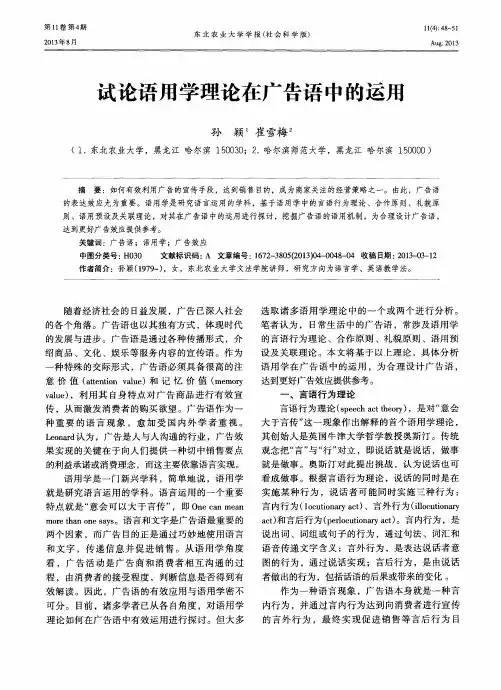
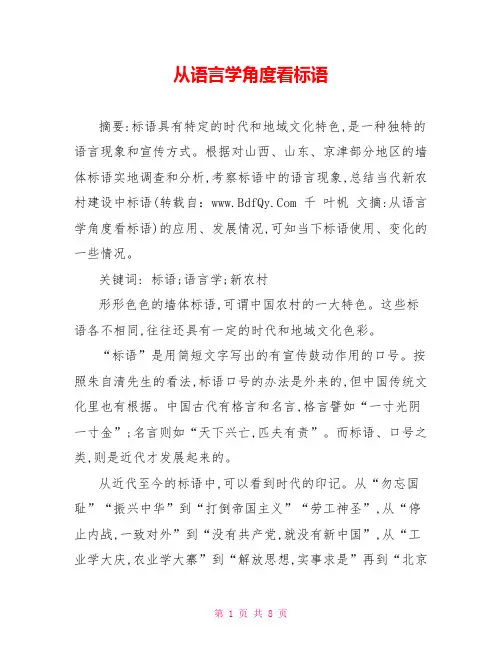
从语言学角度看标语摘要:标语具有特定的时代和地域文化特色,是一种独特的语言现象和宣传方式。
根据对山西、山东、京津部分地区的墙体标语实地调查和分析,考察标语中的语言现象,总结当代新农村建设中标语(转载自: 千叶帆文摘:从语言学角度看标语)的应用、发展情况,可知当下标语使用、变化的一些情况。
关键词: 标语;语言学;新农村形形色色的墙体标语,可谓中国农村的一大特色。
这些标语各不相同,往往还具有一定的时代和地域文化色彩。
“标语”是用简短文字写出的有宣传鼓动作用的口号。
按照朱自清先生的看法,标语口号的办法是外来的,但中国传统文化里也有根据。
中国古代有格言和名言,格言譬如“一寸光阴一寸金”;名言则如“天下兴亡,匹夫有责”。
而标语、口号之类,则是近代才发展起来的。
从近代至今的标语中,可以看到时代的印记。
从“勿忘国耻”“振兴中华”到“打倒帝国主义”“劳工神圣”,从“停止内战,一致对外”到“没有共产党,就没有新中国”,从“工业学大庆,农业学大寨”到“解放思想,实事求是”再到“北京欢迎你”,标语这种特殊的宣传方式,记录了中国的近、现、当代史。
当代,随着城市化的逐步加快,城市中的标语逐渐减少,尤其是粉刷的墙体标语都销声匿迹了,只有诸如“点燃激情,传递梦想”“构建社会主义和谐社会”等宣传横幅或者彩色招贴。
而在广大的农村,墙体标语仍然广泛存在着,并始终是一种宣传方式。
在新农村建设中,作为一种宣传途径,当今存在什幺样的标语、需要什幺样的标语、标语应如何发展,是应当引起关注的。
一、调查目的在社会主义新农村建设中,农村的文化建设是一个重要方面。
相比于城市,农村的人口平均文化水平比较低,信息传播、社会宣传等手段相对落后,口头传话、喇叭广播等简单方式仍占较大比重。
相对于口头的声音,墙体标语相对固定,存留时间较长,对村民潜移默化的宣传影响比较大。
标语大体包括宣传党政方针、法律、计生、环保、交通、卫生、基础教育等方面,又可分为宣传鼓励类和禁止警告类。
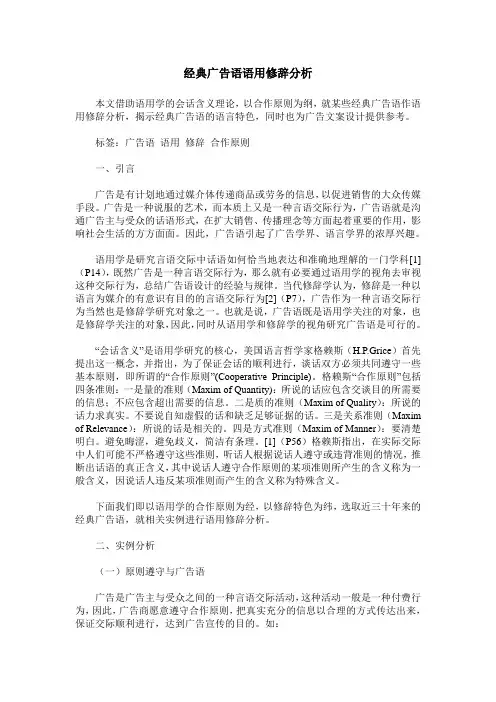
经典广告语语用修辞分析本文借助语用学的会话含义理论,以合作原则为纲,就某些经典广告语作语用修辞分析,揭示经典广告语的语言特色,同时也为广告文案设计提供参考。
标签:广告语语用修辞合作原则一、引言广告是有计划地通过媒介体传递商品或劳务的信息,以促进销售的大众传媒手段。
广告是一种说服的艺术,而本质上又是一种言语交际行为,广告语就是沟通广告主与受众的话语形式,在扩大销售、传播理念等方面起着重要的作用,影响社会生活的方方面面。
因此,广告语引起了广告学界、语言学界的浓厚兴趣。
语用学是研究言语交际中话语如何恰当地表达和准确地理解的一门学科[1](P14),既然广告是一种言语交际行为,那么就有必要通过语用学的视角去审视这种交际行为,总结广告语设计的经验与规律。
当代修辞学认为,修辞是一种以语言为媒介的有意识有目的的言语交际行为[2](P7),广告作为一种言语交际行为当然也是修辞学研究对象之一。
也就是说,广告语既是语用学关注的对象,也是修辞学关注的对象,因此,同时从语用学和修辞学的视角研究广告语是可行的。
“会话含义”是语用学研究的核心,美国语言哲学家格赖斯(H.P.Grice)首先提出这一概念,并指出,为了保证会话的顺利进行,谈话双方必须共同遵守一些基本原则,即所谓的“合作原则”(Cooperative Principle)。
格赖斯“合作原则”包括四条准则:一是量的准则(Maxim of Quantity):所说的话应包含交谈目的所需要的信息;不应包含超出需要的信息。
二是质的准则(Maxim of Quality):所说的话力求真实。
不要说自知虚假的话和缺乏足够证据的话。
三是关系准则(Maxim of Relevance):所说的话是相关的。
四是方式准则(Maxim of Manner):要清楚明白。
避免晦涩,避免歧义,简洁有条理。
[1](P56)格赖斯指出,在实际交际中人们可能不严格遵守这些准则,听话人根据说话人遵守或违背准则的情况,推断出话语的真正含义,其中说话人遵守合作原则的某项准则所产生的含义称为一般含义,因说话人违反某项准则而产生的含义称为特殊含义。
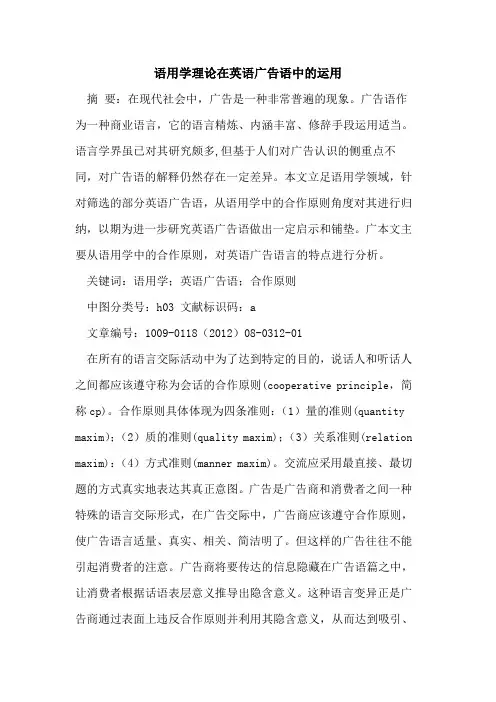
语用学理论在英语广告语中的运用摘要:在现代社会中,广告是一种非常普遍的现象。
广告语作为一种商业语言,它的语言精炼、内涵丰富、修辞手段运用适当。
语言学界虽已对其研究颇多,但基于人们对广告认识的侧重点不同,对广告语的解释仍然存在一定差异。
本文立足语用学领域,针对筛选的部分英语广告语,从语用学中的合作原则角度对其进行归纳,以期为进一步研究英语广告语做出一定启示和铺垫。
广本文主要从语用学中的合作原则,对英语广告语言的特点进行分析。
关键词:语用学;英语广告语;合作原则中图分类号:h03 文献标识码:a文章编号:1009-0118(2012)08-0312-01在所有的语言交际活动中为了达到特定的目的,说话人和听话人之间都应该遵守称为会话的合作原则(cooperative principle,简称cp)。
合作原则具体体现为四条准则:(1)量的准则(quantity maxim);(2)质的准则(quality maxim);(3)关系准则(relation maxim):(4)方式准则(manner maxim)。
交流应采用最直接、最切题的方式真实地表达其真正意图。
广告是广告商和消费者之间一种特殊的语言交际形式,在广告交际中,广告商应该遵守合作原则,使广告语言适量、真实、相关、简洁明了。
但这样的广告往往不能引起消费者的注意。
广告商将要传达的信息隐藏在广告语篇之中,让消费者根据话语表层意义推导出隐含意义。
这种语言变异正是广告商通过表面上违反合作原则并利用其隐含意义,从而达到吸引、鼓动、说服消费者接受并这刺激其消费的欲望,最终达到促销产品的目的。
一、违反量的准则根据量的准则,广告商提供的信息应是消费者所需的,不应过多也不宜过少。
过多会使广告繁冗,不利消费者记忆。
过少,消费者对广告的内容、目的,不会很明确。
但实际上,许多广告商都有意地、公开地传递过多或过少信息。
多余信息看似不必要或不相关,实际蕴藏着一定的含义;少量信息可以存激发消费者的想象力,产生购买欲望。
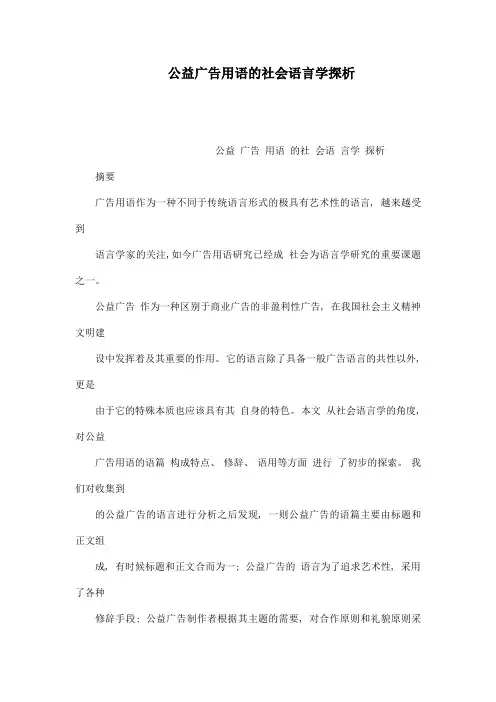
公益广告用语的社会语言学探析公益广告用语的社会语言学探析摘要广告用语作为一种不同于传统语言形式的极具有艺术性的语言, 越来越受到语言学家的关注,如今广告用语研究已经成社会为语言学研究的重要课题之一。
公益广告作为一种区别于商业广告的非盈利性广告, 在我国社会主义精神文明建设中发挥着及其重要的作用。
它的语言除了具备一般广告语言的共性以外, 更是由于它的特殊本质也应该具有其自身的特色。
本文从社会语言学的角度, 对公益广告用语的语篇构成特点、修辞、语用等方面进行了初步的探索。
我们对收集到的公益广告的语言进行分析之后发现, 一则公益广告的语篇主要由标题和正文组成, 有时候标题和正文合而为一; 公益广告的语言为了追求艺术性, 采用了各种修辞手段; 公益广告制作者根据其主题的需要, 对合作原则和礼貌原则采取了灵活运用; 最后我们在分析语料的基础上, 找出了我国现存公益广告用语中的典型性弊病, 并对其原因进行了探索。
关键词 :公益广告用语语篇修辞语用公益广告用语的社会语言学探析AbstractAs a kind of artistic language which is different from traditional language, theadvertising expression has drawn more and more linguists’attention, and now it hasalready become an important subject in the field of social linguistics. The publicinterest advertisement, a kind of non-profit advertisement which is different from thecommercial advertisement, is playing a vital role in our spiritual civilizationconstruction. Because of its special essense, its expressions should also have its owncharacteristic besides have the common advertisement expressions’general characterIn this thesis, I make a brief probe into the passage structure characteristic, pragmaticbasis and rhetoric of the public interest advertising expressions in the field of sociallinguistics. By analyzing the public interest advertising expressions we collected, wefound that its passage structure is mainly composed by the title and the main textwhich sometimes combine into one speech.In order to persure the artistry, the publicinterest advertising expressions has used some rhetorical ploys. According to itssubject, the fabricant have adopted the nimble utilization to the cooperation principleand politeness principle. Last, on the base of analizing the language material, wediscovered some typical disease in the extant public interest advertising expressions ,and then has carried on the exploration to its reasonKey words: public interest advertising expressions passage structure characteristic rhetoric pragmatic basis公益广告用语的社会语言学探析目录中文摘要Ⅰ英文摘要Ⅱ目录?? Ⅲ第一章绪论??(1)1.1 选题缘起??(1)1.2 研究目的??(1)1.3 研究现状(2)1.4 研究对象的界定?(3)1.5 语料的选取??(4)第二章公益广告语篇构成分析(5 )2.1 标题? (5)2.2 正文 (6)第三章公益广告用语常用的修辞手法(9) 3.1 比喻? (9)3.2 比拟 (10)3.3 夸张 (12)3.4 双关 (12)3.5 反语 (13)3.6 引用 (14)3.7 排比 (15)3.8 对偶 (15)3.9 反问 (16)3.10 析字 (17)3.11 仿拟 (17)3.12 拈连 (18)3.13 小结 (18)第四章公益广告用语的语用基础 ?(20 )4.1 合作原则及其运用 (20)4.2 礼貌原则及其运用 (23) 公益广告用语的社会语言学探析4.3 小结? (25)第五章讨论 ?(26)5.1 公益广告用语中存在的弊病(26)5.2 弊病形成的原因分析 (28)结语? (30)注释? (31)参考文献?(32 )后记? (34) 公益广告用语的社会语言学探析第一章绪论1.1 选题缘起法国著名新闻工作者罗培尔? 凯兰曾说 : “我们呼吸的空气是由氧气、氮气和广告组[1]成。
广告是一种传播信息的活动,它服务于企业的经营活动,着力于促进企业的产品销售。
广告的目标在于树立品牌形象,宣传产品性能,吸引顾客消费。
广告可采用横幅标语、街头招牌、电视画面和报纸专栏等多种形式。
无论何种形式,文案设计都至关重要。
为使广告语成为最易煽动人心的利器,许多文案设计中都运用了修辞(邹燕、徐富平,2002:63)。
广告的定义和特点:广告一般都有时效性,在短时间之内引起消费者的注意力是关键,所以广告一定要简洁易懂,能实实在在地抓住人,让消费者在短时间之内了解商品的用途并产生购买的欲望。
美国语言哲学家格赖斯(Grice )指出,为了保证会话的顺利进行,谈话双方必须共同遵守一些基本原则,即所谓的“合作原则(cooperative principle )”。
合作原则包括四大准则:1.量的准则(maxim of quantity ):所说的内容应该包含交际所需要的信息,不应该包含超过需要的信息;2.质的准则(maxim of quality ):努力让你说的话是真的,不要说你知道是虚假的话,不要说没有足够证据的话语;3.关联准则(maxim of relation ):有关联;4.方式准则(maxim of manner ):说话要清楚,避免晦涩、歧义、啰嗦,要简练、井井有条。
广告语的宣传是一种说服性的语用言语行为,其目的在于提升品牌影响力,并且说服消费者接受其所宣传的产品(徐巧燕,2018:140)。
在广告词中加入修辞,可以增强广告语言的表达效果,同时唤起人们的情感共鸣。
广告文案中也经常使用修辞来增强广告的感染力。
广告词目前基本被分为两种,一种是遵循合作原则,另一种是违反合作原则。
遵循合作原则是中规中矩,而违反合作原则是反其道而行之,以出其不意而致胜。
这可以让消费者对产品加深了解,同时广告词对于消费者心理的精准把控也能够刺激消费。
语用与修辞活动存在高度统一(刘丽华,2006:87)。
故本文主要结合实例,从语用学角度下的合作原则出发,以薇诺娜广告词为例,对违反量的准则、质的准则、关联准则以及方式准则的广告修辞特点进行实例分析,探讨化妆品广告词的语言特征。
汉语广告语中的语用预设分析广告语作为一种非常特殊的文体,它的主要目的是吸引更多消费者,促进产品销量。
其实这也是一种交际活动,它体现了广告设计者、企业与消费群体之间的互动。
在广告语中,设计师经常使用预设这一策略,然后把其中的隐含意义传达给消费者。
本文将从语用预设的角度来分析广告语中的预设现象。
一、引言预设这一语言现象最早是由德国哲学家弗雷格(Frege)于1892年提出的,是在区分“意义”与“所指”时开始注意到这个现象的,这时预设还处于逻辑学、语言哲学领域。
到20世纪60年代,预设开始进入语言学领域,它最早出现在真实条件语义学研究中,并在语义学范围内得到较充分的发展。
后来语用学的兴起为这个概念增添了新的研究视角。
语言学家对预设的定义基本分为语义和语用预设两种类型。
语义预设被看作是两个语义命题间的一种关系,而语用预设的定义则存在分歧,有人把它看作说话人对语境所做的设想,也有人把它看作是交际双方所共有的知识。
在我国,最早引入“预设”概念的则是北京大学的胡壮麟教授。
1980年,胡壮麟教授在《国外语言学》杂志上发表了《语用学》一文,他在文中阐述逻辑—语义学的预设和语用学的预设的区别时,介绍了基南对预设概念的理解。
之后,国内著名学者沈家煊、王维贤、何自然、何兆熊、束定芳等又对预设这一语言现象进行了研究。
广告语作为一种非常特殊的文体,折射了商家的营销方式和手段,在广告语中,通常会用到预设这一策略,从而让广告语中的隐含意义传达给消费者,促进产品销售并提升企业形象。
陈新仁先生(1998)将广告语中的语用预设分为四种,即事实预设、信念预设、状态预设和行为预设。
(一)事实预设。
事实预设是指说话人主观断言存在的一种事实性的预设,同时说话人还认为听话人也相信这一事实。
这就成为说话者双方交际活动中一个事实预设。
此类预设多采用肯定句式陈述单向事实,下不容否定的结论等来加深消费者对产品的印象,赢得消费者的赞同和肯定。
例如:1.只溶在口,不溶在手——巧克力。
广告用语中的语用预设分析语用预设相对于话语理解而言具备合适性和共知性,而其本身则具有单向性,主观性和隐蔽性。
广告是一种极具策略性的交际行为,广告用语正是巧妙地运用了语用预设这三个特性衍生出的交际所需的策略性。
其实对语用预设的选用就是对消费者心理的把握。
标签:广告用语语用预设策略一、前言广告不仅是一门艺术,而且是一种特殊的交际形式。
从语用学角度讲,言语性广告宣传是一种语用行为,具体地说是一种说服性言语行为,其目的在于说服交际对象(消费者)接受其产品。
这种行为带有明显的功利性,它往往通过某种策略去获取。
研究广告用语可与解释交际者(广告制作中)的语用心理,洞察广告宣传背后的诱导机制。
本文通过探讨广告中大量存在的语用预设使用的情况,从侧面了解广告制作者的语用心理策略。
二、关于语用预设什么是语用预设?语用预设就是从语用上分析出的预设,或称语用前提,是指“那些对语境敏感的,与说话人(有时还包括说话对象)的信念、态度、意图有关的前提关系”(何自然,1997)。
“前提”是言语交际双方都早已知道的常识,或至少听到话语之后总能根据语境推断出来的信息。
Levinson将语用预设总结为两个基本概念:合适性(appropriateness or felicity)和共知性(mutual knowledge or common ground)。
“合适性”是说预设要与语境紧密结合,预设是言语行为的先决条件。
(何自然,1998) 例如:对于同一则广告来说,可能因语境不同会暗示着不同的预设。
1.好空调不分国界(空调广告)这则广告可能是在不同的语用前提下说出来的:A.我们生产的这种空调是地地道道的国产货,却可以与外国货相媲美。
B.这种空调在我们生产过销路很好,出口到你们国家销路也会不错的,因此它是好空调。
“共知性”是指预设是交际双方共有的背景知识,这种共有的背景知识在话语的发出和理解的过程中起着十分重要的作用。
这种重要性体现在:一方面,说话者可以依据这种共有知识对话语进行动态选择,进而恰当地表达自己的思想;另一方面,听话者也能够利用它来透过表面的语言现象看本质的思想,寻找理解话语的最佳相关,以便了解说话者的真正思想和意图。
从语用学的视角浅析广告词从语用学的视角浅析广告词有创意的广告词会给受众留下深刻印象,同时也提高了产品的知名度,使商家达到增加效益的目的。
本文从语用学的视角浅析广告词,欢迎阅读了解。
摘要: 广告语言是一种特殊的语言交际形式。
有创意的广告词因其独特的语言魅力而给受众留下了深刻印象,同时也提高了产品的知名度,使商家达到增加效益的目的。
本文用格赖斯的会话含意理论对广告词从格氏量、质、关系、方式四种准则的违反情况加以解释和分析。
关键词: 语用学广告词会话会意1.引言美国广告学家克劳德霍普金斯将广告定义为:“广告是将各种高度精练的信息,采用艺术手法,通过各种媒介传播给大众,以加强或改变人们的观念,最终引导人们的行动的事物和活动。
”[1]对受众来说,广告语言不仅提供了产品的有关信息,广告的言语手段和言语方式也影响着他们的情感、态度和行为倾向,它通过运用独特的语言达到促进商品消费的目的。
一则优秀的广告口号一般具有简洁明了、新颖独特、亲切感人、鼓动力大等特点。
然而商业的激烈竞争也使得广告语言的使用大胆创新。
本文将用格赖斯的会话含意理论对广告词加以解释和分析。
2.从会话含意理论对广告词进行分析从交际的角度来看,一则广告词的传播实际上是广告业主与广告受众之间的言语交际行为。
广告词的风格各异,有的简洁明了,有的含意深远。
因此对广告词的言外之意、弦外之音的理解就非常重要。
2.1理论背景格赖斯提出了会话含意理论,格氏认为,为了保证会话的顺利进行,谈话双方都遵守着一些基本准则,特别是所谓“合作原则”。
格赖斯将“合作原则”划分为“质”、“量”、“关系”和“方式”四个范畴,每个范畴包括若干个“准则”和“次准则”。
[2]但是,格赖斯又指出,在实际交际中人们并不是都严格遵守这些原则。
当一方违反了这些原则时,另一方就要迫使自己超越对方话语的表面意义去设法领会说话人话语中的深一层含义,寻求说话人在什么地方体现着合作原则,于是就产生了会话含意理论。
中西方文化的广告文本语用分析与比较一、前言随着全球化进程的加速,各种文化在相互交流与融合的过程中,广告作为信息传播和文化交流的重要方式,不断在不同文化中流传。
因此,通过对中西方广告语的比较和分析,不仅可以帮助我们更好地理解文化的差异和特点,还可以为我们的跨文化交流提供更好的指导。
二、语用分析与比较1、语用分析语用学是对语言的使用及其含义进行分析的学科。
在广告语中,语言使用者的意图、文化背景以及接受者的阅读反应等诸多因素都会影响广告效果的达成。
例如,中西方在表达产品功能时的差异,以可可银行为例,在中国,它的宣传广告语是“安全可靠的银行”,而在西方,同样的宣传广告语则是“最受欢迎的金融服务机构”。
这一组广告文本语进行了语用分析,可以发现,中西方在语言使用上存在差异。
在中文广告语中看重的是产品的稳定性、安全性和可靠性等功能属性,而在英文广告语中则突出了消费者对品牌的认同和对品牌的喜爱。
此外,习惯和情感领域也是广告语的重要语用学分析领域。
以中式文化广告语为例,表现出对传统文化和家庭情感的美好渴望。
西式广告语倾向于追求个性化,出彩且让消费者强烈印象深刻,个性强、引人注目。
中西方广告语的比较,展现出了文化价值观、消费习惯和情感体验的语用关系。
2、语用比较(1)文化差异中西方文化的差异为广告语创意提供了不同的灵感。
中式广告语常常强调传统的信仰观念,比如尊重长辈、重视分内的职责和仁爱之心。
而西式广告语更加注重创意和差异化。
以手机广告为例,在中国市场上,厂商通常通过手机品质、功能、花式壳等方式进行推广;而在西方市场上,厂商更倾向于用美女姿势、思维火花等方式进行宣传。
(2)市场需求中西方消费者的需求和消费习惯也存在很大的差异。
例如,在时尚类别广告中,西方广告强调时尚波动不定,多样性、创造性和独特性,并注重实际功能和时尚使用的可能性,而中国广告强调文化的永恒和传承,强调福利、情感需求、防御、恐惧、不安或团体关系等复杂的诉求。
从语用角度分析广告英语中的模糊限制语的开题报告1. 研究背景广告英语是一种特殊的语言形式,其目的是吸引消费者购买产品或服务。
为了达到这个目的,广告英语中常常使用模糊限制语,如“可能”、“或许”、“人人都喜欢”等,来表达产品或服务的好处,但同时又对其进行一定的限制。
这种语言形式在实际生活中广泛存在,对消费者做出正确选择具有一定的影响。
因此,从语用角度研究广告英语中模糊限制语的使用,对于了解其语用功能与效果,提高消费者的广告识别能力具有重要意义。
2. 研究对象与方法本研究将以广告英语中模糊限制语的使用为研究对象,选取一定数量的广告语料,通过文本分析的方法进行数据收集与分析。
利用语用学的相关理论,探讨模糊限制语的语用功能、表达效果与影响,分析其在广告中的使用特点、流行趋势、消费者理解与识别方式等方面。
3. 研究意义广告英语中的模糊限制语是一种广告商为了达到营销目的而采取的一种语言策略。
研究其语用功能,不仅有助于了解广告语言的特点,还可以深入了解消费者在理解广告语言时的共识与偏见。
通过深入研究广告英语中模糊限制语的使用,可以对广告制作和广告识别者的实际生活产生积极的帮助和指导。
此外,本研究还为广告语言的研究提供了新的思路和方法,对语用学相关理论的深入探讨具有重要的参考价值。
4. 参考文献罗格斯,E. R. (1992). Understanding advertising: An audience-centered approach. Lawrence Erlbaum Associates.周伟力,徐健民. (2011). 英语广告语的功能与表现探析. 语言与翻译, (4), 36-38.黄利平. (2015). 广告英语“可能性”副词的语用聚焦. 点线面, (06), 40-43.。
Analyzing Characteristics of English Advertisement Language From the Perspective of PragmaticsXingrui LiuSchool of Foreign Languages, Yunnan Normal University, Kunming, P.R. ChinaAbstractAdvertising guru Ogilvie oncce said, advertising is the life of the words. His words point out the importance of advertising language for advertising. In the fierce competitive contemporary society, businessmen try to make use of a variety of advertising to promote products and services in order to quickly expand their products in the market. Because among various kinds of advertisement, a distinctive advertising language plays a great role in selling products. Advertising text is widely concerned by scholars at home and abroad because of its remarkable characteristics. Analyzing characteristics of English advertisement language from the perspective of pragmatics, it’s not difficult to find harmonious and unified context is beneficial to enrich advertisement information and promote the understanding of advertising . Smart advertisers will often hide transfer the information in the presupposition of advertising language, release products information and promote products in the market with the help of presupposition; the advertising language through violation of the cooperative principle intentionally or unintentionally in public to transfer products information, so that consumers can infer the conversational implicature instead of it’s surface meaning, therefore,businessmen are able to highlight the characteristics and advantages of their products .Keywords: advertising language; pragmatics; theory; usage1. IntroductionAdvertisements are getting their way into our daily life: they may smile to us from the television screen, shout to us from the radio loudspeakers, wave invitingly to us fromevery page of the newspaper and magazine, pluck at our sleeves on the buses and escalators, signal to us from roadside billboards and flash to us on the Internet. Advertisements, in any of mass media communication frequently make use of the direct approach of rhetorical devices to objectify appeals and enhance its persuasive power.However, when a large number of marvelous advertisements flood into another nation, their renditions could not always be as wonderful as the original and, therefore, might fail to produce similar effects on the target audience. Puzzled and stimulated by this problem, the author of this thesis has made an intensive study of analyzing the characteristics of English advertising language from the perspective of pragmatics to find a way of improving the efficiency of advertisement.With the establishment of socialist market economy and the rapid expansion of economic exchanges, especially after China’s entry into the WTO, international economic activities become more frequent and foreign trade more active. A successful advertisement, fine in the use of words, sentences, and rhetoric in order to be new, vivid and fascinating, is a unique and crafted product of creators. Through the examples of English advertisement, this paper mainly explores the way of improving the efficiency of advertisement.Advertising has become a popular subject of numerous scholarly studies approached from a wide range of disciplines, such as anthropology, sociology, psychology, linguistics, literary criticism, aesthetics, marketing and media studies, for all kinds of advertisements have bombarded each of us in our daily life. Advertisements from the highways, radio, TV, magazines, newspapers and the Internet invade our ears and eyes with repetitive message and arouse our attention. Advertising is an effective and critical tool not only to promote tangible commodities and services such as hairdressing but also to promote economic, political, religious and social ideas. The essence of advertis ing’s global significance may have been captured by the British novelist Noman Douglas when he remarked, “You can tell the ideals of nation by its advertisements” (Wilson, 1989:263). Therefore, the study of advertising has taken on new significance.Advertising English is a style of immediate impact and rapid persuasion. The point of an advertisement is to persuade people of the merits of a particular product or service, in order that people will part with some of their money. In general, whether the medium is print, radio or television, the advertiser can rely on people’s attention for only a very short time. Therefore, the sales message must be short, clear, distinctive and memorable.The paper is composed of four parts. The first part presents the main concern of the thesis and its main theme. In part two, a general study of advertising. Based on the literature review, we are going to know more about the principles used to express the usages of advertising English. Then part three is devoted to the study of the pragmatic basis of English advertising language. Part four is the summary of this thesis.2. A General Study of Advertising2.1 Literature ReviewThe quality of advertising language to some degree determines the effect of an advertisement (hereinafter referred to as “ad”). The literature of the earlier period include Bovee’s Contemporary Advertising, Higgins’The Art of Writing Advertising: Conversations with Masters of the Craft, and Ulanoff’s Advertising in America, while Principles of Advertising co-written by Monle and Carla follow into the category of recent works. These publications are mainly devoted to media strategy, marketing planning process, customer behavior, public relation and the ways ads are presented (size, color and position), and seldom lay enough emphasis on copywriting, which has an indispensable relationship with language. Furthermore, the part organized around copywriting only clarifies advertising structure (namely, headline, subhead, body copy, slogan and closing), copy devices (namely, format, design and illustration), and ideas of how to bring originality to copywriting. It seems that marketing perspective of advertising has overwhelmed its linguistic features, which is generally considered as a research objective of studies by the linguists.2.2 Definition of AdvertisingThe English word, advertise, means to draw something through newspapers, handbills, radio, etc, so as to make people want to buy it. Up to now, various definitions of advertising have been made from different perspectives. However, the underlying function of advertisement to inform and its ultimate goal to sell remain unchanged. In the Britannica Encyclopedia: advertising is generally defined as any openly sponsored offering of goods, services, or ideas through any medium of public communication. Today, the widely adopted definition was put forward by the American Marketing Association:“Advertising is the nonpersonal communication of information, usually paid for and usually persuasive in nature, about products (goods and services) or ideas by identified sponsors through the various media.”2.3 The Characteristics of English Advertising Language2.3.1 Lexical Features2.3.1.1 Using More Positive AdjectivesAdvertising language often uses amount of modifiers to make advertising vivid and interesting enough to appeal to consumers. And adjectives become the preferential choice. The British linguist G.H.Leech rank the advertising English adjectives according to their frequency in advertising, the first ten are:(1)new(2)good/better/best(3)free(4)fresh(5)delicious(6)full(7)sure (8)wonderful(9)clean(10)specialeg1.A brand new Hyatt. A whole new feeling.(Hyatt Hotel)eg2.Feel good. Fast food.(Top Shelf Fast Food)2.3.1.2 Using Monosyllabic Verbs frequentlyThe most basi c feature of Advertising is it’s concise in choosing advertising words, and the most eloquent is probably verbs and adjectives. While monosyllabic words are often used .The following monosyllabic words are used most frequently in English advertising:(1) buy (2) see (3) get (4) use (5) choose (6) feel (7) go (8) have (9) keep (10) give (11) like (12) look (13) love (14) need (15) save (16) take (17) make (18) know (19)come (20) enjoyeg1. The First Ever. The Last You’ll Ever Need.(Seiko wristwatch)eg2. Three Letters that Bring the World Together.(YKK zipper)2.3.1.3 The Innovative Onomatopoeia CombinationOften making use of the homonym of words to make advertisement vivid and attractive in English advertisements,For example.He’s never gone a sleeper befor e,Because he wets the bed...(But tonight, with Goodnites, that will change.)Goodnites means Good mornings.There are a few words selected from the Goodnite urine pants ads, this advertisement makes full use of the homonym between Goodnite and Goodnight, stressing that you can have a wonderful overnight sleep if you wear the Goodnite urine trousers, hence enjoying the fun of sleeping out, it also and emphasizes a good sleep will guarantee you have a wonderful morning.eg2. InLondon Airport, there is one line of words in front of a duty-free shop "Have a nice tripe. Buy-buy!" At first glance, as if it is wrong, it should be Bye-bye! However,thinking carefully, “buy-buy” reminds you of buying some duty-free products before flying .It is such an ingenious advertisement.2.3.2 The Characteristics of Sentence PatternsThe often used sentence patterns in English advertisements are ellipsis sentence, imperative sentence and interrogative sentence, and most of them are short and clear with rapid rhythm, so it is easy to remember. A lot of English advertising slogan has been known to every household, for example:eg1. Come alive with Pepsi! (Pepsi drink)eg2. Soft shoes for hard world. (Ultrasoft women's shoes)Advertisement is fond of using a variety form of rhetoric, according to statistics, themost important title of an English advertisement document utilizing rhetorical has the proportion as high as 86% (McQuarieer&Mick, 1992), the commonly used rhetorical forms in English advertisements are "personification, analogy, pun, repeated" (Zhao Jing, 1992: 278-283). The purpose of applying rhetorical is to highlight the key information, on the other hand, to attract the target audience.eg1.I’m more satisfied. Ask for More. (More cigarette)eg2. Opportunity knocks!(A real estate advertisement)2.4 Functions of AdvertisingAs is known to everyone, the effects of advertising and advertisers are greatly criticized in the following aspects: 1) Advertising increases the living cost because its costs are added to the prices; 2) Advertising encourages the wrong values in our society-consumer values, make people purchase things they do not need, or even cannot afford. These criticisms do really reflect the fact to some degree. Nevertheless, we should see the other side of the coin. Advertising tells us a great deal about our society, and helps to influence and change it. Although the aim of the ad is to sell products, its function doesn’t stop there. In practice, that is where it starts. Advertising is the first to reflect and stimulate social trends. Basically, advertising fulfills the following functions:1)The Marketing Function;2) The Educational Function;3) The Communicative Function;4) The Economic Function;5) The Societal Function.2.5 The Target Audience of Advertising LanguageAdvertising is the extension of human communication, it origins from the need of disseminating products information massively. The ultimate aim of advertising is to create the attitude and behavior which is conducive to sales, the British linguist Torben (1985) classified the advertising functions as follows: 1) the dissemination of information; 2) the shape of image; 3) to persuade the reader to take action. Differentforms of communication have their unique focus on both sides. Literary creation is concerned with expressing the author own feelings,science and technology review pays attention to the reader's understanding but not cater to the tastes of readers. While in advertising activities, all aims at the target audience (potential consumers), the target audience’s understanding and respond to advertising information often determine the success or failure of the expensive advertising campaign. Therefore, it is extremely critical to choose the appropriate English advertising language, vivid and interesting language is capable of attract the target audience’s attention and interest to the products, so as to stimulate the desire to buy.3. The pragmatic Basis of English Advertising Language3.1 ContextContext refers to the "speech act depends on the performance of the physical and social environment". Context consists of linguistic context and non-linguistic environment. The former mainly refers to the language symbol system within the context. Context restricts the use of linguistic symbols to a certain extent, at the same time, it can also promote the understanding of language symbols. Linguistic context caused by harmonious and unified context is beneficial to enrich advertising information and promote the understanding of advertising. In respect to linguistic context, non-linguistic context have more restriction on advertising language, accordingly, the available accommodation is greater than linguistic context. The advertiser tries to adapt to Veschueren’s "Theory of Adaptation"to better illustr ate. The theory points out, during the process of using language, the language choosed by speaker should adapt to the context. The process that speakers choose language is a dynamic process conformed to himself and listener’s psychological world. The process that speakers using language is the process of selecting language. Starting from the intention of communicator, communicators must select appropriate content, occasion, manner, and determine what should say or what should not say, expressly or implied. Therefore, in order to achieve the anticipated effect, advertisers must estimate the advertising target audience in the first place, and then generateadvertising discourse to adapt to the psychology and taste of consumers.For example, Nescafe Coffee have an advert known to every family: It is the taste! Which is translated as "the taste is great". However, once the advert separates itself from the context, the meaning of this sentence is uncertain, because the word "taste" can be understood as good taste, can also be understood as bad taste. But this is a slogan to propaganda Coffee the good taste of Nescafe Coffee, naturally, it is very appropriate to translate it into "delicious". If you change a situation, the contextual effect is totally opposite. For example: When a child went home from school, he immediately opened the cookie jar and picked up a biscuit into his mouth, then his mother asked him why he did not have meal in school, the children answered: It is the taste! Taste here can only be understood as the school lunch taste terrible., as a result, he would rather eat biscuits than eat at school. Obviously, the same word may have entirely different meanings in different context.3.2 Speech ActAccording to Austen, language is used for doing things. When we say a series of language that is a request, indicating or have other functions, we are concerned with the speaker’s and the listener’s response. This language entity is called"speech act" by Austen. A series of concrete request, indicating is considered to do things: locutionary act, illocutionary act, perlocutionary act. And analysis an English advertisement language by means of Austen’s Speech act theory .Are You Trying to Be “Too Perfect”?1)Do you get caught up in details, no matter what job you undertake?2)Do you worry more than most people?3)Do you find it embarrassing to “lose control” and be emotional?4)If thinking about some future event, do you dwell upon the things that might go wrong?“Yes” answers indicate that your need for control is comp romising your ability to experience life’ simple, spontaneous pleasures. Read TOO PERFECT:When being in control-the self-help book for people who try to be too perfect for their own good.$18.00,now at your bookstore.According to Austen's speech act theory, the discourse strategy of this English advertisement is the illocutionary act, namely, the advertiser uses words to do things through discourse strategies, that is to say, transferring the literal meaning of advertising through grammar and vocabulary. The discourse function of this article is the illocutionary act, advertisers attract consumers to buy this book through the discourse. Once spoken, one will concentrate on the audience's feelings, thoughts and behavior, this is the perlocutionary act. The consequence of this text is to persuade consumers to buy this book. When the advertising is able to stir consumers’ desire to buy, it has achieved the anticipated effect, that is to say the discourse communication is successful. Therefore, in addition to the content and the packing of the book, advertising language plays a decisive role in the sales process.3.3 The Conversational ImplicatureThe concept of conversational implicature was first proposed by American linguist H.P.Grice, Based on his cooperate principle, the later researchers complement the politeness principle and developed a new theory - neo-Gricean theory of conversational implicature, compared with the previous theory of Conversational Implicature , the new theory focus on dealing with the "normal" meaning included in conversation by using inference mechanism, and the previous conversational implicature theory tends to understand the "very" meaning, namely, to find the discourse implication by complying with or violating the use cooperative principle. The target of English advertising is to attract the consumers, and its ultimate purpose is to let the audience react favorably to advertising (to purchase products ), but English advertising always uses circuitous equivocate in language expression to impress the audience, so as to let the audience feel the quality of products out of the ordinary and buy the products finally.eg1. Where do you want to go today?(software advertisement of Microsoft company)eg2.Unlike me, my Rolex never needs a rest. (Rolex watch ads)eg3. Wentworth’s students get Auto CAD edge in job hunt. (Recruitment advertising)In example 1, the surface meaning of the sentence is: where did you go today? Whereas as it is a software advertising, the target audience can easily infer its implication, that is Microsoft software will take you travel around the world. And in example 2, the advertisement stresses that Rolex watches never need to have a rest while it will provide the right time forever. For example 3, it implies the commitment of school enrollment: If you are going to be our students, you will get Auto CAD (Computer Aided Design) edge which is essential in job hunt. The statement is not only close to the readers, but also urge the reader into potential students, namely, encouraging students to be their students.3.4 The Politeness PrincipleLeech (1983) thinks that, only through the politeness principle can more fully explain the relevant implication (implicature) and the indirect speech act and other issues. Advertisers have to hide the real communicative intention in the advertising by using of euphemism, indirect, polite words to transform the mandatory speech act into speech act commitment, naturally, turning the proposition of "persuade the consumer to buy a product" int o "a product can bring benefits for consumers”, embodying the maximum of “Yuantong standards" and "generous rule" in Leech’s politeness principle. Businessmen require to exaggerate the benefits to the target audience so that consumers have the feeling of gaining benefits from the purchase. In order to get a better understanding of this two rules, let’s review the two maxims of politeness principle in Leech theory:The Yuantong criterion: reducing the expression that hurts others.1) making others suffe as little as possible ; 2) making others benefit as much as possibleThe generous standards: reducing the expression of self-interest.1) benefiting himself as little as possible; 2)suffering oneself as much as possibleeg1. If you have a taste for quality,you have the taste for Kent. (Kent cigarette)eg2. Four free nights at Five-Star hotel,free airfare,free transfers,and a journeythrough a land of enchantment aboard a magnificent Renaissance Cruises ship.In example1: You will choose Kent cigarette if you have a good taste. The advertisement is very artful is not that it directs you buy his goods by raising your identity instead of ordering you to buy Kent cigarettes. In example 2, the word “Free” has great temptation for consumers, for all the “free charge products” have the magic power of making people have a try. American famous advertiser David Ogily once said, "The powerful words you can use in a headline are free and new." However, advertisers will never send their goods without paying, so the word free is rarely used in commodity brand, it’s function is to attract consumers to buy products or receive services.3.5 Relevance TheoryIn the advertisement, advertisers make use of the coexist cognitive environment with consumers and readers to strive to achieve the mutual manifestness and form the best contextual effect, so as to make consumers completely fall in the atmosphere created by businessmen, at the same time, the reader can also fully understand that the real intention of the advertiser. For example: Not all cars are created equal. (Japan Mitsubishi car) , this seems difficult to understand at first glance, but the trick is that it uses the familiar American declaration of independence in the line "All men are created equal", Japan advertisers cha nge the word “men” in the declaration to “cars” in their advertisement, and change the certainly sentence into negative sentences. These changes reflect the relevance theory, namely, the use of the coexist cognitive environment with consumers and readers to guide the readers understand the real purpose of their advertising: Japanese car is better than other cars produced by other countries all over the world; And another classical example, “We take no pride and prejudice”. (the magazine of Time), readers wi ll naturally think of the famous work Pride and Prejudice wrote by the famous British writer Austen at the first glance. 4. ConclusionWhether the English advertising language can accurately convey information to desire consumers buy one’s products or serv ice is the ultimate aim of advertisement.Analyzing English advertising language from the perspective of pragmatics canprovide reference for the choice and innovation of English advertising language. ReferencesLeech, G. N. (1996). Language in Advertising: A Linguistic Study of Advertising in Great Britain. London: Longman.Bovee, Courtland L, and Arens, Wiqiam F. (1994): Contemporary Advertising. New York:Richard D. Irwin Inc.Schroder. (1985). The language of advertising. Oxford and New York: Wiley Blackwell.Monle, Lee & Carla, Johnson. (1999). Principles of Advertising:A Global Perspective.New York: Haworth Press.崔刚. (1993). 广告英语3000句. 北京: 北京理工大学出版社.赵静. (1992). 广告英语.北京: 外语教学与研究出版社.王琼. (2003). 商标与广告主题句翻译的特色艺术.外语教学.(5),47-50刘丽. (2009). 英汉广告语篇组织模式比较研究. 河南大学硕士学位论文.张艳军. (2010). 英语招生广告分析:评价理论视角. 河南大学硕士学位论文.。